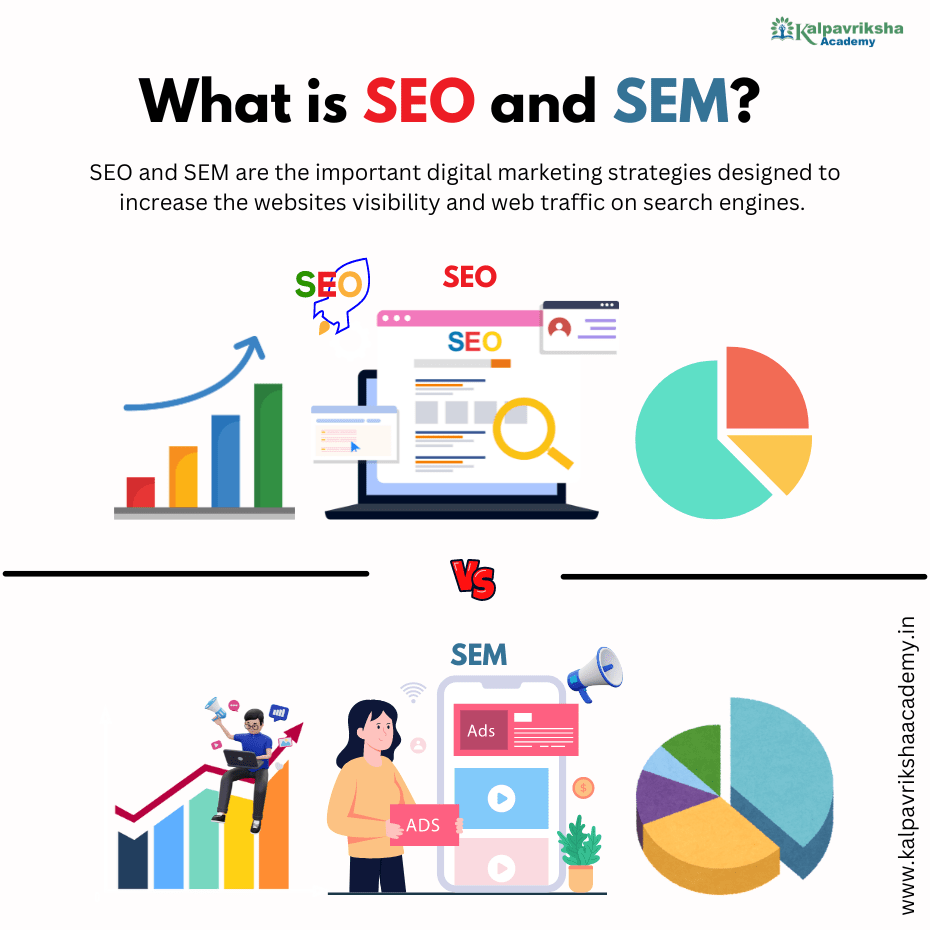What is SEO and SEM?
SEO and SEM are most the important digital marketing strategies designed to increase the websites visibility and web traffic on search engines. Now let’s understand the meanings and difference between SEO and SEM.
SEO (Search Engine Optimization) – SEO is the process of using free online advertising to increase a website’s results page visibility on particular search engines. By raising a website’s ranking on search engine results pages, it is used to drive more traffic to that website.
SEM ( Search Engine Marketing ) – SEM is the process of using advertisements that are paid to increase a website’s position in search engine results on a particular search engine. It covers pay-per-click (PPC), AdWords, social networking, contextual advertising, AdSense, and search engine optimization, among other things.
To Read more in Details Visit this Link – What is SEO and SEM?

Benefits of SEO and SEM Marketing
Comparing the benefits of SEO and SEM marketing, both have different kinds of benefits targeting other needs and goals. If one wants to be cost-effective, then SEO is much better at giving a website much better visibility through its organic search results.
There are two major benefits of SEO and SEM marketing associated with it: long-term results and no cost for placements to keep the traffic going. Not only does it normally improve credibility and trust of the users with the website, but more often than not, the high organic rankings also provide higher click-through rates for better returns on investment in the long term.
Though it does require an up-front investment of time or money, its benefits grow further with an increase in authority and ranking.
SEM includes paid advertising techniques, such as Google Ads, for instant coverage and generation of traffic. Since SEM involves highly targeted audiences, it provides very close to instant targeting by keyword, demographic, and user behavior. SEM allows budgetary, placement, and time control over the ads, with measurable results and detailed analytics that guide campaign optimization.
SEM also enables an increase in brand awareness through repetition in search results, even if the user never clicks on the ad. On the downside, it requires constant investment to maintain its visibility and results.
This can be done through proper integration of SEO and SEM marketing to balance a business approach with the long-term benefits associated with organic search, along with capitalizing on the immediate effect of a paid advertisement.
It is because of this combination that maximum online presence is realized and comprehensive results are driven, thus eventually linking short-term objectives to long-term strategies of growth.

What is the Difference Between SEO and SEM?
In digital marketing, the difference between SEO and SEM are two distinct strategies used to enhance a website’s visibility on search engines. Here’s a clear breakdown of their differences:
SEO (Search Engine Optimization)
SEO: An approach that uses organic methods to appear in search results.
- Definition: SEO simply means optimizing a website to realize improved rankings organically, that is, non-paid on major search engines. Its objective is enhancing its visibility on SERPs using search engine results pages through unpaid methods.
- Focus: SEO targets on the improved website positioning for the desired keywords; it focuses on three areas: content, structure and technical features.
The three types of SEO include on-page SEO (which comprises content and also meta tags), off-page SEO (links from other official sites) as well as technical SEO (involving how fast a site loads or if it can be displayed in mobile devices). - Cost: Because there are no extra charges from search engines, the SEO will prove to be really cost-effective in due course. But to achieve this end, one has to invest time and the amount of money that ensures its long lasting nature.
- Time Frame: SEO is something which usually requires some period of time before it really pays off.
This will improve the ranking and organic traffic within a matter of months because it requires the crawling and indexing of a website by search engines, a really time-consuming procedure. - Sustainability: High rankings, therefore, need an optimization process to be kept up continuously. Simplify: SEO is a long-term process; it’s like turning on organic traffic ..
- Results: Metrics such as organic search traffic, keyword rankings, and website authority are used to measure SEO outcomes.
Relevant Blog – On Page and Off Page SEO: Importance, Differences and Tools
SEM (Search Engine Marketing)
SEM: An approach that uses paid methods to appear in search results.
- Definition: It’s a broad term encompassing both SEO and paid search advertising popularly known as PPC or Pay-Per-Click. SEM refers to paid strategies that better the visibility of a website on any search engine.
- Focus: It contains majorly the campaigns of paid advertisement, as in Google Ads, where businesses bid to have their ads at the very top of the results that the search engine returns. It comprises advertisements budget management, ad targeting, and ad performance optimization.
- Cost: There are direct costs with SEM; a business pays for ad placements. The cost will vary depending on keyword competitiveness, ad quality, and bidding strategies.
- Time frame: SEM can instantaneously produce results. Ads start sending in traffic immediately when a campaign is launched and approved thus making this method quicker than SEO.
- Sustainability: Results from SEM are temporary and completely dependent on ad spend. If you ever stop spending your money, the inclusion just evaporates. SEM requires an investment that continuously has to be made to hold that traffic and visibility organically.
- Results: Results from SEM are measured by metrics, including CTR, Conversion Rate, and ROAS.

What is the Difference Between SEO and SEM in Digital Marketing?
Even though they both act on the change in a website’s visibility in a search engine, SEO and SEM are two very different approaches, bearing particular features in digital marketing. Now let’s understand the difference between SEO and SEM marketing.
Search Engine Optimization, shortly called SEO, is the process of enhancing a website for it to achieve higher positioning in organic, non-paid search engine result pages.
Information goes hand in hand with on-page elements, which include such things as content, meta tags, and technical factors like site speed and mobile compatibility just a few of many specific areas that go into evolving the performance of a website.
Clearly, what this does is add to relevance and bolster a site’s authority to get a higher ranking in the search engines. Theoretically, it’s cost-effective in the long term since it does not involve any payment to search engines.
In reality, however, intense, steady work will normally be required over a few months to bring about high-level improvements in rankings.
Results from SEO are sustainable, providing ongoing benefits once high rankings are achieved. SEM actually includes two interlinking procedures: SEO and paid search advertising.
It’s actually the whole process of creation and handling of ad campaigns through various search engines like Google Ads, which places a business by bidding on specific keywords to have its ads highly placed on pages of search results.
It gives immediate visibility and traffic, targeting definite demographics, locations, and users’ behaviors. It is a highly granular method of ad placement and budgetary control; however, it is a continuous paid visibility. Although SEM can be quite responsive, their advantages come to a complete stop the moment ad spend stops.
While both have an almost similar purpose, the working goes unlike each other. SEO is a long-term strategy focused on organic growth and cost-effectiveness, while SEM produces instant results as it advertises and targets.
Both can be used together for a website to achieve this maximum potential and visibility in search engines. From the above article you got an understanding of the difference between SEO and SEM in digital marketing.
Elevate Your Skills with Our SEO & SEM Course at Kalpavriksha Academy
You have the opportunity to significantly influence your future, whether your goal is to improve your skills or advance your career with SEO. Join us today to begin your journey to success. Our committed team is here to support you every step of the way! Don’t let this chance get away from you. Enroll in the SEO course at Kalpavriksha Academy right away to gain the abilities, know-how, and self-assurance required to realize your goals.
FAQs
1. What is the main difference between SEO and SEM?
SEO (Search Engine Optimization) focuses on improving a website’s organic search rankings through techniques like keyword optimization, content creation, and technical enhancements. SEM (Search Engine Marketing) includes both SEO and SEM paid advertising strategies, such as Google Ads, to achieve immediate visibility and drive targeted traffic through paid placements.
2. How quickly can I see results from SEM?
SEM provides immediate visibility. Once a campaign is launched, ads can start appearing in search results almost instantly, generating traffic right away. This makes SEM ideal for short-term goals and quick results, though ongoing investment is required to maintain performance.
3. Is SEO or SEM more cost-effective?
It is said to be cost-effective in the long run since it does not have ongoing payments to search engines for placing an ad. In this way, once a site achieves high organic rankings with SEO, it can continue to draw traffic with minimal costs. SEM, however, requires continuous investment for ad spend that could amount to a lot depending on how stiff competition may be or how long the campaign is.
4. Can I use SEO and SEM together?
Yes, this can prove to be an extremely powerful combination: both SEO and SEM. SEO, in its very nature, lays the groundwork for long-term organic visibility and credibility, whereas SEM drives instant traffic since it targets a small, more precise audience with its paid ads. A website running both strategies will make sure it has maximized its position on a search engine and will bring quite comprehensive results at once.
5. How do I choose between SEO and SEM marketing?
The choice between SEO and SEM marketing will have to be based on your business goals, budget, and timeline. If you want long-term growth and cost-effective strategies, then the way to go would have to be SEO. However, if you are looking to focus highly on ads with instant results, then SEM can be the way to go. Most businesses, however, really do greatly benefit from combining them in such a manner that drives balanced results.
Tags – digital marketing, difference between SEO and SEM










